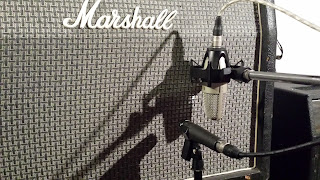 By Tim Dolbear
By Tim Dolbearwww.timdolbear.com
sE Electronics is the maker of many outstanding microphones, including my all time favorite small diaphragm condensers, The sE5. I fell in love with The sE5 while trying them out for my MIX review and you can read about them here:
MIX magazine review - sE5
Chris Dauray who works with sE and helped me out on the MIX review, setup me up with a few more 'of my choice' mics to try out. This time it was the Z5600a II multi-pattern large diaphragm condenser and a pair of Voodoo ribbon mics.
First up is the Z5600a II. $1249 list
This is a 9 pattern tube condenser mic with built in -10 db pad and HP filter. It comes in a great flight case with remote power supply that also has the pattern selection on it, a large and of quality shock mount, and cabling.
The sound is upfront, mid-range focused and filled with harmonics, as you'd expect from a tube mic that has a good transformer in the output stage. The polar patterns range from Omni through Cardio to figure 8. I liked the sound of the mic in Omni pattern more than cardio. Example, when tracking acoustic guitar, Set to cardio, the sound of the strings and left hand came through, but in Omni, the entire instrument came through. Also the added depth of the room came to life in Omni.
It was a very nice feature being able to dial in the polar patterns, if I wanted a Cardio pattern that was slightly more open than normal, simple select the setting that works. Very cool!

This mic would find itself at home tracking vocals for Rock and hardrock. This mic is on my list of wants for future purchases. :-)
Next up is the sE Voodoo Ribbon mic VR1. $499List
These are small passive ribbon mics that have an extended high range and are not a budget ribbon mic. I have try others in the $200-600 range and hated them, terrible. The Royer ribbon mics start at $1000 and I just have not gotten a chance to use them as I figured I would want to buy it if I loved it... So if the VR1 sounds of the quality of the $1000+ ribbons, I am in business. The VR1 comes in at half the price and with so many engineers bragging about their beautiful high end response and rich mids and lows, I could not wait to try them out.
The VR1 do not have a HP filter and of course due to the low output inherent to a ribbon microphone's design, no pad. Also, the VR1 has a transform on it's output so if you hit the mic with 48v phantom power, the mic will not have issue. This is unlike most ribbon mics on the market which will fry an ugly death if you accidentally hit them with phantom power.
I received a pair of mics so I could test them as overheads for drums, but first up was what these are known for and I had waited a long time to get them in here to try out; Electric Guitars.
 The VR1 sounded creamy yet tight, smooth frequency response and no "dull high-end" like I have run into in the past with ribbons. It made my SM57 (Transformer-less) sound very upfront and tight but not in a good way. In fact, I could not believe how bad my normal guitar amping mics (SM57 transformer-less and Audix D1) sounded in comparison to the VR1.
The VR1 sounded creamy yet tight, smooth frequency response and no "dull high-end" like I have run into in the past with ribbons. It made my SM57 (Transformer-less) sound very upfront and tight but not in a good way. In fact, I could not believe how bad my normal guitar amping mics (SM57 transformer-less and Audix D1) sounded in comparison to the VR1.The VR1 just Killed it!
Compared with my Shure KSM27, a condenser mic I often use for electric guitar, it simply had a more creamy smooth sound, the KSM sounded bright and even a tad harsh. Since the VR1 is a figure 8 pattern as most all ribbon mics are, it kept up with the condenser as they both had depth and "room" in their sound. The two complimented each other very well.
The VR1 is now my go to electric guitar mic. Its fantastic!
Many of my friends like ribbon mics as overheads, but for me I am not really a fan. First you need to be in a room with at least a 15ft ceiling as the figure 8 pattern catches reflections off the ceiling and kills the sound. Also the sound of a ribbon on a kit is very dull and not modern sounding to me at all. Even in a throwback vintage sounding recording, its not the sound I would look for. Just not to my personal taste.
Also if you are using a set of ribbons for over heads, I would only use a single as having 2 mics both in figure 8 pattern over a kit can cause all sorts of phase issues not to mention all the reflections being picked up. Just my 2cents.
I do look forward to using them on Horns (Brass) as I know the will be perfect. These have found a new home. I really really like these Ribbons and they deserve the hype they get.
Bravo sE, Bravo!
'till next time!











































